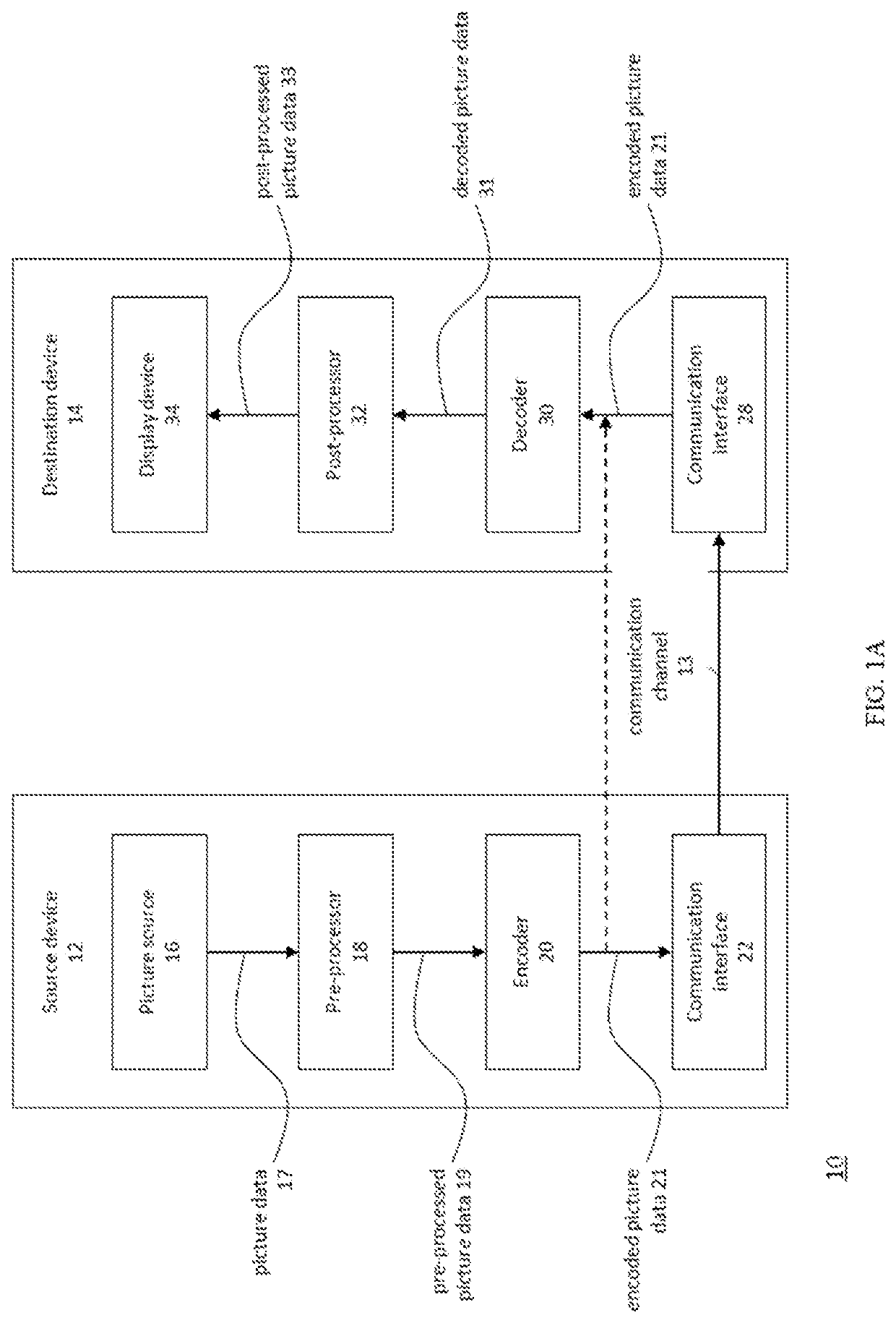Usage of DCT Based Interpolation Filter and Enhanced Bilinear Interpolation Filter in Affine Motion Compensation
a bilinear interpolation and filter technology, applied in the field of picture processing, can solve problems such as inability to apply
- Summary
- Abstract
- Description
- Claims
- Application Information
AI Technical Summary
Benefits of technology
Problems solved by technology
Method used
Image
Examples
example 1
[0242]In this example, EIF comprising bilinear interpolation and high-pass filtering, is used for pixel based motion compensation, predefined sub-block size, used to decide applicability of pixel based motion compensation, is equal to 4×4, maximum number of fetched lines during processing the first line R is equal to 3, dX[0] corresponds to dHorX, dX[1] corresponds to dHorY, dY[0] corresponds to dVerX and dY[1] corresponds to dVerY.
[0243]The variables dX[0], dX[1], dY[0], dY[1] are in 1 / 512 precision.
[0244]The first and the second sub-block size threshold are the same and corresponds to the square block with size N×N, where N is equal to 8.
[0245]The variable eifSubblockSize is set equal to 4.
[0246]The variable eifCanBeApplied is derived as follows:
eifCanBeApplied is set to TRUEThe arrays X[i], Y[i] are derived as follows:X[0] = 0X[1] = ( eifSubblockSize + 1 ) * ( dX[0] + ( 1 X[2] = ( eifSubblockSize + 1 ) * dY[0]X[3] = X[1] + X[2]Y[0] = 0Y[1] = ( eifSubblockSize + 1 ) * dX[1]Y[2] = ...
example 2
[0247]In this example, EIF sub-block size is equal to 8×8, maximum number of fetched lines during processing the first line R is equal to 4, dX[0] corresponds to dHorX, dX[1] corresponds to dHorY, dY[0] corresponds to dVerX and dY[1] corresponds to dVerY.
The variables dX[0], dX[1], dY[0], dY[1] are in 1 / 512 precision....The variable eifSubblockSize is set equal to 8.The variable eifCanBeApplied is derived as follows: eifCanBeApplied is set to TRUE The arrays X[i], Y[i] are derived as follows: X[0] = 0 X[1] = ( eifSubblockSize + 1 ) * ( dX[0] + ( 1 X[2] = ( eifSubblockSize + 1 ) * dY[0] X[3] = X[1] + X[2] Y[0] = 0 Y[1] = ( eifSubblockSize + 1 ) * dX[1] Y[2] = ( eifSubblockSize + 1 ) * ( dY[1] + ( 1 Y[3] = Y[1] + Y[2] The variable Xmax is set equal to maximum of X[i] for i is equal 0..3 The variable Xmin is set equal to minimum of X[i] for i is equal 0..3 The variable Ymax is set equal to maximum of Y[i] for i is equal 0..3 The variable Ymin is set equal to minimum of Y[i] for i is ...
example 3
[0248]In this example, EIF sub-block size is equal to 8×8, maximum number of fetched lines during processing the first line R is equal to 5, dX[0] corresponds to dHorX, dX[1] corresponds to dHorY, dY[0] corresponds to dVerX and dY[1] corresponds to dVerY.
The variables dX[0], dX[1], dY[0], dY[1] are in 1 / 512 precision....The variable eifSubblockSize is set equal to 8.The variable eifCanBeApplied is derived as follows: eifCanBeApplied is set to TRUE The arrays X[i], Y[i] are derived as follows: X[0] = 0 X[1] = ( eifSubblockSize + 1 ) * ( dX[0] + ( 1 X[2] = ( eifSubblockSize + 1 ) * dY[0] X[3] = X[1] + X[2] Y[0] = 0 Y[1] = ( eifSubblockSize + 1 ) * dX[1] Y[2] = ( eifSubblockSize + 1 ) * ( dY[1] + ( 1 Y[3] = Y[1] + Y[2] The variable Xmax is set equal to maximum of X[i] for i is equal 0..3 The variable Xmin is set equal to minimum of X[i] for i is equal 0..3 The variable Ymax is set equal to maximum of Y[i] for i is equal 0..3 The variable Ymin is set equal to minimum of Y[i] for i is ...
PUM
 Login to View More
Login to View More Abstract
Description
Claims
Application Information
 Login to View More
Login to View More - R&D
- Intellectual Property
- Life Sciences
- Materials
- Tech Scout
- Unparalleled Data Quality
- Higher Quality Content
- 60% Fewer Hallucinations
Browse by: Latest US Patents, China's latest patents, Technical Efficacy Thesaurus, Application Domain, Technology Topic, Popular Technical Reports.
© 2025 PatSnap. All rights reserved.Legal|Privacy policy|Modern Slavery Act Transparency Statement|Sitemap|About US| Contact US: help@patsnap.com



